HR Reward Management: Challenges and Motivation Post-COVID-19
VerifiedAdded on 2022/07/06
|17
|3180
|40
Report
AI Summary
This report delves into the complexities of reward and performance management in the wake of the COVID-19 pandemic. It examines the challenges Human Resources will face, including temporary pay cuts, benefit provisions, talent scarcity, and redefining organizational culture. The report also explores ways to improve wage inequality, emphasizing job evaluation, addressing the gender pay gap, and ethical considerations. Furthermore, it discusses strategies for keeping staff motivated, including Maslow's hierarchy of needs and Vroom's expectancy theory, along with practical motivational tools. The report concludes with recommendations to facilitate reward management and improve employee outcomes.

SID #1922807/1
REWARD MANAGEMENT
Element: 010 - Written Report
Student ID: 1922807/1
Lecturer: Irma Cadogan
Date: 18th December 2021
Word Count: 3000
REWARD MANAGEMENT
Element: 010 - Written Report
Student ID: 1922807/1
Lecturer: Irma Cadogan
Date: 18th December 2021
Word Count: 3000
Paraphrase This Document
Need a fresh take? Get an instant paraphrase of this document with our AI Paraphraser

1
Contents
1.0 Introduction ............................................................................................................... 2
2.0 Problems and Analysis .............................................................................................. 4
2.1 What are the main reward management challenges HR will face post-COVID 19? 4
3.0 How can wage inequality be improved in a post-pandemic world? ......................... 5
4.0 What can employers do to keep staff motivated? ..................................................... 6
4.1.1 Theories of motivation ........................................................................................ 7
Conclusion ......................................................................................................................... 12
Recommendations ............................................................................................................. 13
References ......................................................................................................................... 15
Contents
1.0 Introduction ............................................................................................................... 2
2.0 Problems and Analysis .............................................................................................. 4
2.1 What are the main reward management challenges HR will face post-COVID 19? 4
3.0 How can wage inequality be improved in a post-pandemic world? ......................... 5
4.0 What can employers do to keep staff motivated? ..................................................... 6
4.1.1 Theories of motivation ........................................................................................ 7
Conclusion ......................................................................................................................... 12
Recommendations ............................................................................................................. 13
References ......................................................................................................................... 15
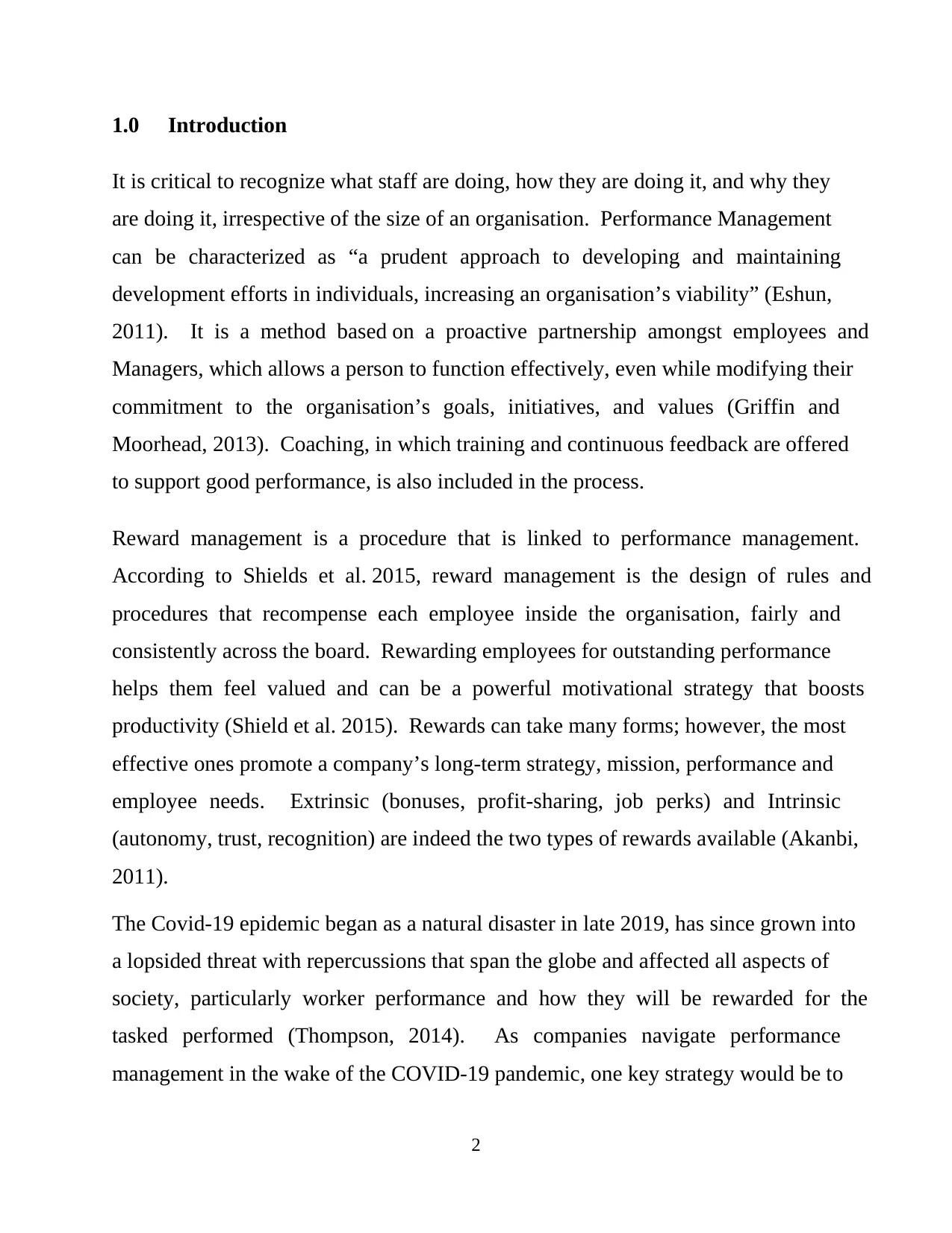
2
1.0 Introduction
It is critical to recognize what staff are doing, how they are doing it, and why they
are doing it, irrespective of the size of an organisation. Performance Management
can be characterized as “a prudent approach to developing and maintaining
development efforts in individuals, increasing an organisation’s viability” (Eshun,
2011). It is a method based on a proactive partnership amongst employees and
Managers, which allows a person to function effectively, even while modifying their
commitment to the organisation’s goals, initiatives, and values (Griffin and
Moorhead, 2013). Coaching, in which training and continuous feedback are offered
to support good performance, is also included in the process.
Reward management is a procedure that is linked to performance management.
According to Shields et al. 2015, reward management is the design of rules and
procedures that recompense each employee inside the organisation, fairly and
consistently across the board. Rewarding employees for outstanding performance
helps them feel valued and can be a powerful motivational strategy that boosts
productivity (Shield et al. 2015). Rewards can take many forms; however, the most
effective ones promote a company’s long-term strategy, mission, performance and
employee needs. Extrinsic (bonuses, profit-sharing, job perks) and Intrinsic
(autonomy, trust, recognition) are indeed the two types of rewards available (Akanbi,
2011).
The Covid-19 epidemic began as a natural disaster in late 2019, has since grown into
a lopsided threat with repercussions that span the globe and affected all aspects of
society, particularly worker performance and how they will be rewarded for the
tasked performed (Thompson, 2014). As companies navigate performance
management in the wake of the COVID-19 pandemic, one key strategy would be to
1.0 Introduction
It is critical to recognize what staff are doing, how they are doing it, and why they
are doing it, irrespective of the size of an organisation. Performance Management
can be characterized as “a prudent approach to developing and maintaining
development efforts in individuals, increasing an organisation’s viability” (Eshun,
2011). It is a method based on a proactive partnership amongst employees and
Managers, which allows a person to function effectively, even while modifying their
commitment to the organisation’s goals, initiatives, and values (Griffin and
Moorhead, 2013). Coaching, in which training and continuous feedback are offered
to support good performance, is also included in the process.
Reward management is a procedure that is linked to performance management.
According to Shields et al. 2015, reward management is the design of rules and
procedures that recompense each employee inside the organisation, fairly and
consistently across the board. Rewarding employees for outstanding performance
helps them feel valued and can be a powerful motivational strategy that boosts
productivity (Shield et al. 2015). Rewards can take many forms; however, the most
effective ones promote a company’s long-term strategy, mission, performance and
employee needs. Extrinsic (bonuses, profit-sharing, job perks) and Intrinsic
(autonomy, trust, recognition) are indeed the two types of rewards available (Akanbi,
2011).
The Covid-19 epidemic began as a natural disaster in late 2019, has since grown into
a lopsided threat with repercussions that span the globe and affected all aspects of
society, particularly worker performance and how they will be rewarded for the
tasked performed (Thompson, 2014). As companies navigate performance
management in the wake of the COVID-19 pandemic, one key strategy would be to
⊘ This is a preview!⊘
Do you want full access?
Subscribe today to unlock all pages.

Trusted by 1+ million students worldwide
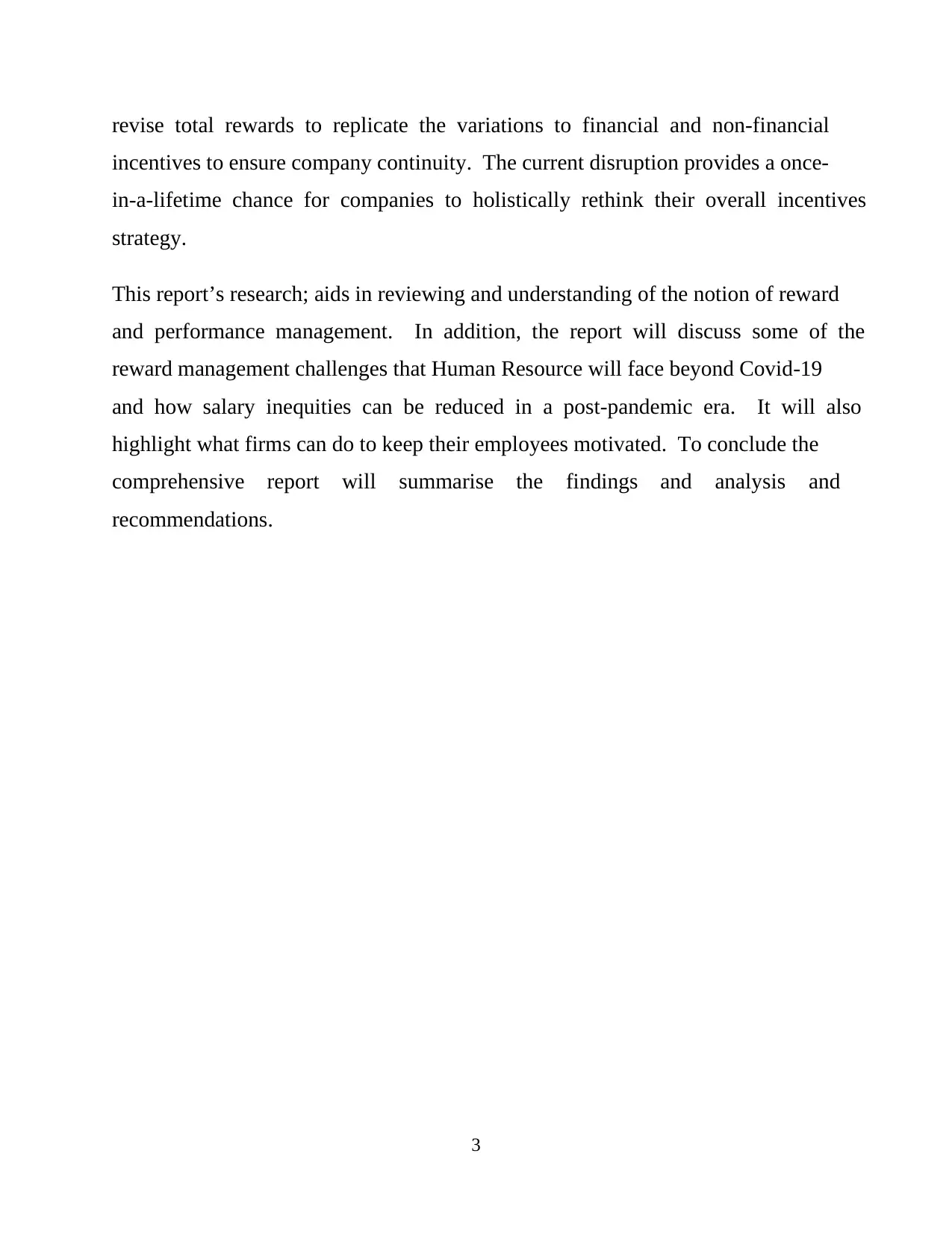
3
revise total rewards to replicate the variations to financial and non-financial
incentives to ensure company continuity. The current disruption provides a once-
in-a-lifetime chance for companies to holistically rethink their overall incentives
strategy.
This report’s research; aids in reviewing and understanding of the notion of reward
and performance management. In addition, the report will discuss some of the
reward management challenges that Human Resource will face beyond Covid-19
and how salary inequities can be reduced in a post-pandemic era. It will also
highlight what firms can do to keep their employees motivated. To conclude the
comprehensive report will summarise the findings and analysis and
recommendations.
revise total rewards to replicate the variations to financial and non-financial
incentives to ensure company continuity. The current disruption provides a once-
in-a-lifetime chance for companies to holistically rethink their overall incentives
strategy.
This report’s research; aids in reviewing and understanding of the notion of reward
and performance management. In addition, the report will discuss some of the
reward management challenges that Human Resource will face beyond Covid-19
and how salary inequities can be reduced in a post-pandemic era. It will also
highlight what firms can do to keep their employees motivated. To conclude the
comprehensive report will summarise the findings and analysis and
recommendations.
Paraphrase This Document
Need a fresh take? Get an instant paraphrase of this document with our AI Paraphraser
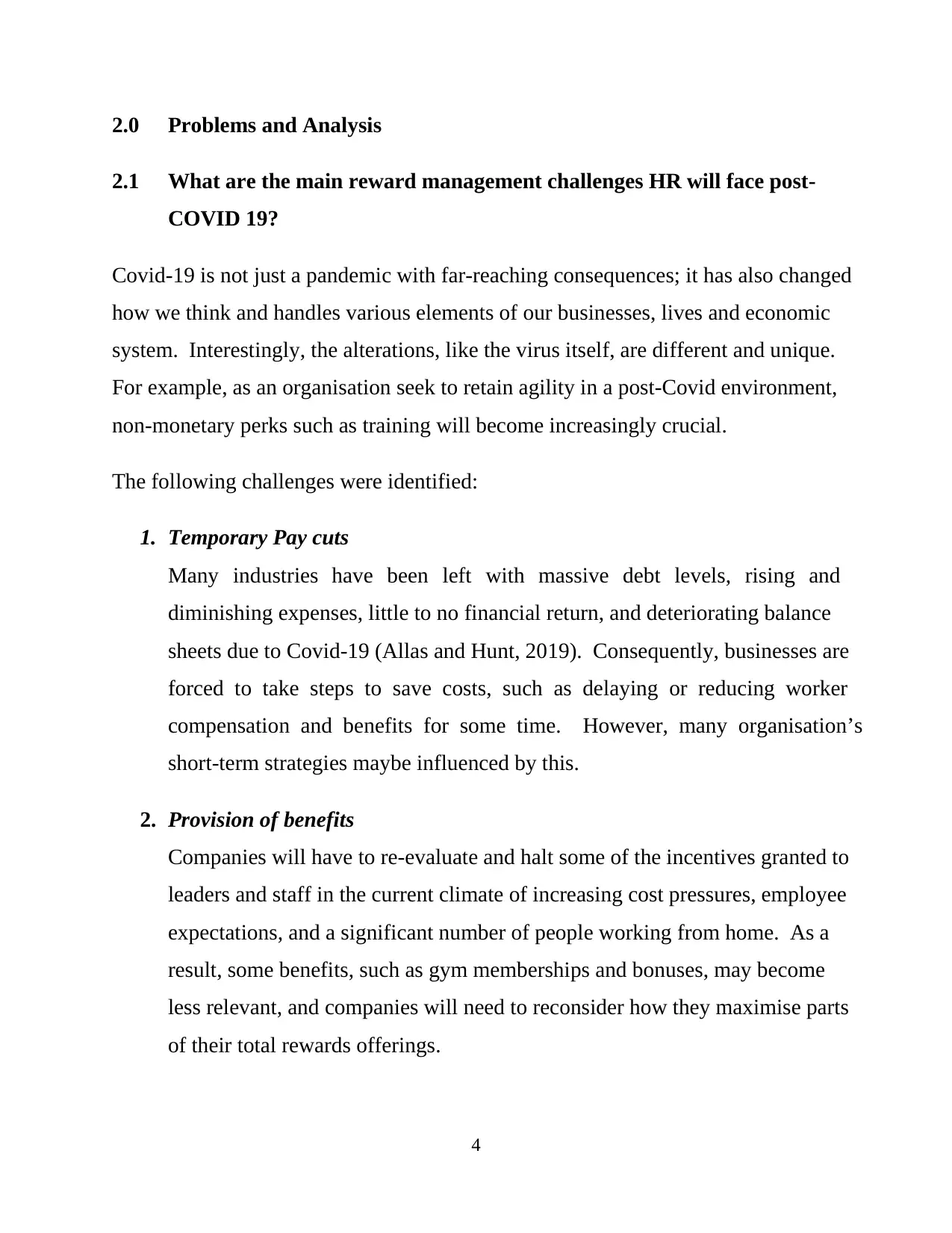
4
2.0 Problems and Analysis
2.1 What are the main reward management challenges HR will face post-
COVID 19?
Covid-19 is not just a pandemic with far-reaching consequences; it has also changed
how we think and handles various elements of our businesses, lives and economic
system. Interestingly, the alterations, like the virus itself, are different and unique.
For example, as an organisation seek to retain agility in a post-Covid environment,
non-monetary perks such as training will become increasingly crucial.
The following challenges were identified:
1. Temporary Pay cuts
Many industries have been left with massive debt levels, rising and
diminishing expenses, little to no financial return, and deteriorating balance
sheets due to Covid-19 (Allas and Hunt, 2019). Consequently, businesses are
forced to take steps to save costs, such as delaying or reducing worker
compensation and benefits for some time. However, many organisation’s
short-term strategies maybe influenced by this.
2. Provision of benefits
Companies will have to re-evaluate and halt some of the incentives granted to
leaders and staff in the current climate of increasing cost pressures, employee
expectations, and a significant number of people working from home. As a
result, some benefits, such as gym memberships and bonuses, may become
less relevant, and companies will need to reconsider how they maximise parts
of their total rewards offerings.
2.0 Problems and Analysis
2.1 What are the main reward management challenges HR will face post-
COVID 19?
Covid-19 is not just a pandemic with far-reaching consequences; it has also changed
how we think and handles various elements of our businesses, lives and economic
system. Interestingly, the alterations, like the virus itself, are different and unique.
For example, as an organisation seek to retain agility in a post-Covid environment,
non-monetary perks such as training will become increasingly crucial.
The following challenges were identified:
1. Temporary Pay cuts
Many industries have been left with massive debt levels, rising and
diminishing expenses, little to no financial return, and deteriorating balance
sheets due to Covid-19 (Allas and Hunt, 2019). Consequently, businesses are
forced to take steps to save costs, such as delaying or reducing worker
compensation and benefits for some time. However, many organisation’s
short-term strategies maybe influenced by this.
2. Provision of benefits
Companies will have to re-evaluate and halt some of the incentives granted to
leaders and staff in the current climate of increasing cost pressures, employee
expectations, and a significant number of people working from home. As a
result, some benefits, such as gym memberships and bonuses, may become
less relevant, and companies will need to reconsider how they maximise parts
of their total rewards offerings.
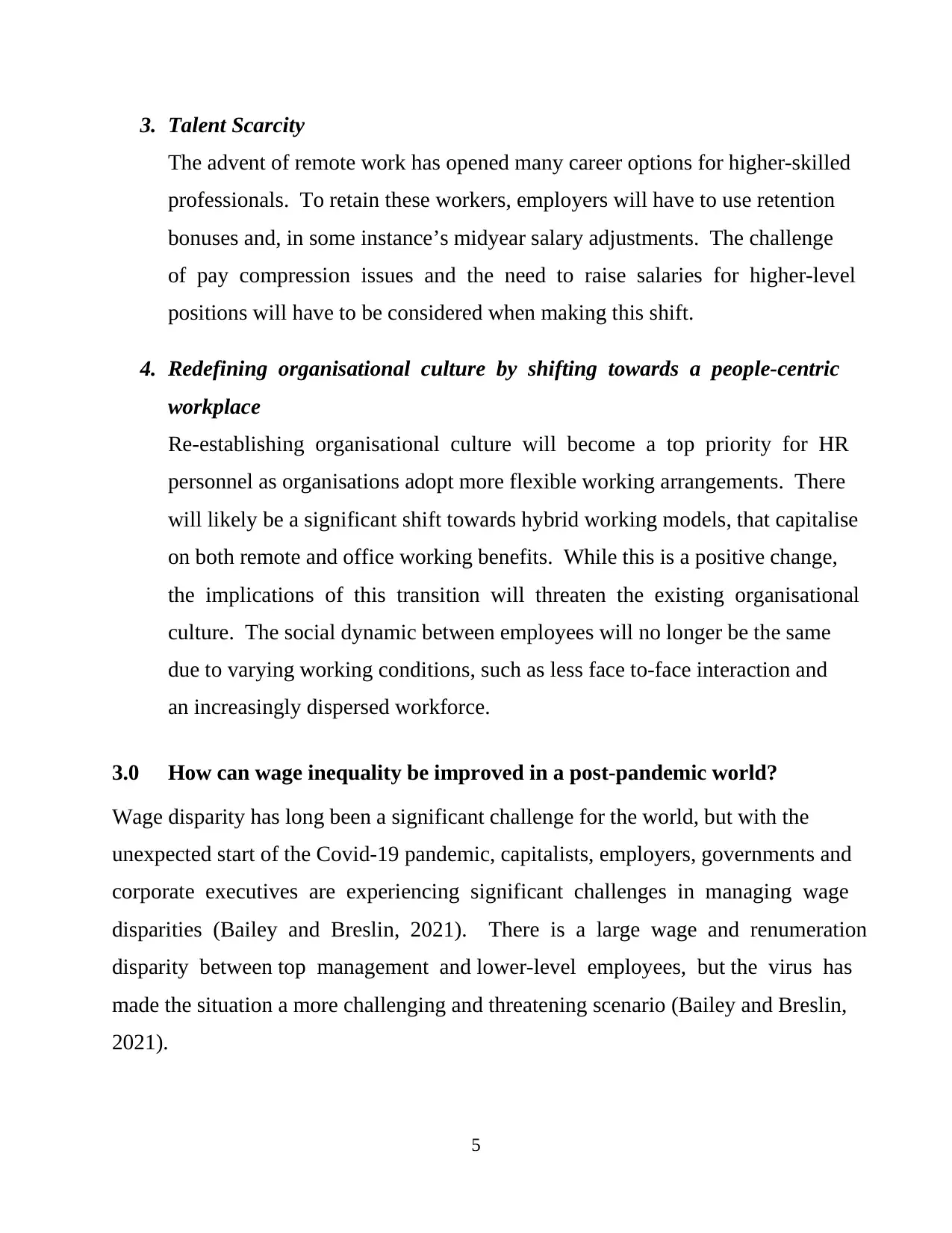
5
3. Talent Scarcity
The advent of remote work has opened many career options for higher-skilled
professionals. To retain these workers, employers will have to use retention
bonuses and, in some instance’s midyear salary adjustments. The challenge
of pay compression issues and the need to raise salaries for higher-level
positions will have to be considered when making this shift.
4. Redefining organisational culture by shifting towards a people-centric
workplace
Re-establishing organisational culture will become a top priority for HR
personnel as organisations adopt more flexible working arrangements. There
will likely be a significant shift towards hybrid working models, that capitalise
on both remote and office working benefits. While this is a positive change,
the implications of this transition will threaten the existing organisational
culture. The social dynamic between employees will no longer be the same
due to varying working conditions, such as less face to-face interaction and
an increasingly dispersed workforce.
3.0 How can wage inequality be improved in a post-pandemic world?
Wage disparity has long been a significant challenge for the world, but with the
unexpected start of the Covid-19 pandemic, capitalists, employers, governments and
corporate executives are experiencing significant challenges in managing wage
disparities (Bailey and Breslin, 2021). There is a large wage and renumeration
disparity between top management and lower-level employees, but the virus has
made the situation a more challenging and threatening scenario (Bailey and Breslin,
2021).
3. Talent Scarcity
The advent of remote work has opened many career options for higher-skilled
professionals. To retain these workers, employers will have to use retention
bonuses and, in some instance’s midyear salary adjustments. The challenge
of pay compression issues and the need to raise salaries for higher-level
positions will have to be considered when making this shift.
4. Redefining organisational culture by shifting towards a people-centric
workplace
Re-establishing organisational culture will become a top priority for HR
personnel as organisations adopt more flexible working arrangements. There
will likely be a significant shift towards hybrid working models, that capitalise
on both remote and office working benefits. While this is a positive change,
the implications of this transition will threaten the existing organisational
culture. The social dynamic between employees will no longer be the same
due to varying working conditions, such as less face to-face interaction and
an increasingly dispersed workforce.
3.0 How can wage inequality be improved in a post-pandemic world?
Wage disparity has long been a significant challenge for the world, but with the
unexpected start of the Covid-19 pandemic, capitalists, employers, governments and
corporate executives are experiencing significant challenges in managing wage
disparities (Bailey and Breslin, 2021). There is a large wage and renumeration
disparity between top management and lower-level employees, but the virus has
made the situation a more challenging and threatening scenario (Bailey and Breslin,
2021).
⊘ This is a preview!⊘
Do you want full access?
Subscribe today to unlock all pages.

Trusted by 1+ million students worldwide

6
1. Job evaluation
Job evaluation is another essential addressable in workplace settings. The
dissatisfaction surmounting the global economic scenario, evaluation of the
employees’ performance is the framework of action and direction in which
the improvement is required (Akanbi, 2021). Assessing performance
management depends mainly on fairness
2. Gender Pay Gap
Despite efforts to improve gender equality in the workplace, women still earn
considerably less than their male colleagues and remain under-represented at
senior level. Employers can support pay transparency to ensure women aren’t
receiving less than men in equivalent roles and should not rely on salary
history to set pay.
3. Ethical Issues
The ethical issues are whether worshipping talent gives door to equality and
inclusion. Absolutely, one size fits all globally and for all the people.
Nevertheless, every single action, scheme, plan, strategy, policy or approach
has merits and demerits. However, if socialism and egalitarianism is the
assessment tool, performance and over-performers can disserve the case.
There is a different dimension too, to look after this issue or ethical dilemma.
If the performers will be given the opportunity to gain respect, equal scope of
hour and dignity as the good performers get and enhance workplace
motivation.
4.0 What can employers do to keep staff motivated?
The motivation of employees is critical to the success of any business or
organisation. A motivated workforce, according to (Armstrong and Taylor,
1. Job evaluation
Job evaluation is another essential addressable in workplace settings. The
dissatisfaction surmounting the global economic scenario, evaluation of the
employees’ performance is the framework of action and direction in which
the improvement is required (Akanbi, 2021). Assessing performance
management depends mainly on fairness
2. Gender Pay Gap
Despite efforts to improve gender equality in the workplace, women still earn
considerably less than their male colleagues and remain under-represented at
senior level. Employers can support pay transparency to ensure women aren’t
receiving less than men in equivalent roles and should not rely on salary
history to set pay.
3. Ethical Issues
The ethical issues are whether worshipping talent gives door to equality and
inclusion. Absolutely, one size fits all globally and for all the people.
Nevertheless, every single action, scheme, plan, strategy, policy or approach
has merits and demerits. However, if socialism and egalitarianism is the
assessment tool, performance and over-performers can disserve the case.
There is a different dimension too, to look after this issue or ethical dilemma.
If the performers will be given the opportunity to gain respect, equal scope of
hour and dignity as the good performers get and enhance workplace
motivation.
4.0 What can employers do to keep staff motivated?
The motivation of employees is critical to the success of any business or
organisation. A motivated workforce, according to (Armstrong and Taylor,
Paraphrase This Document
Need a fresh take? Get an instant paraphrase of this document with our AI Paraphraser
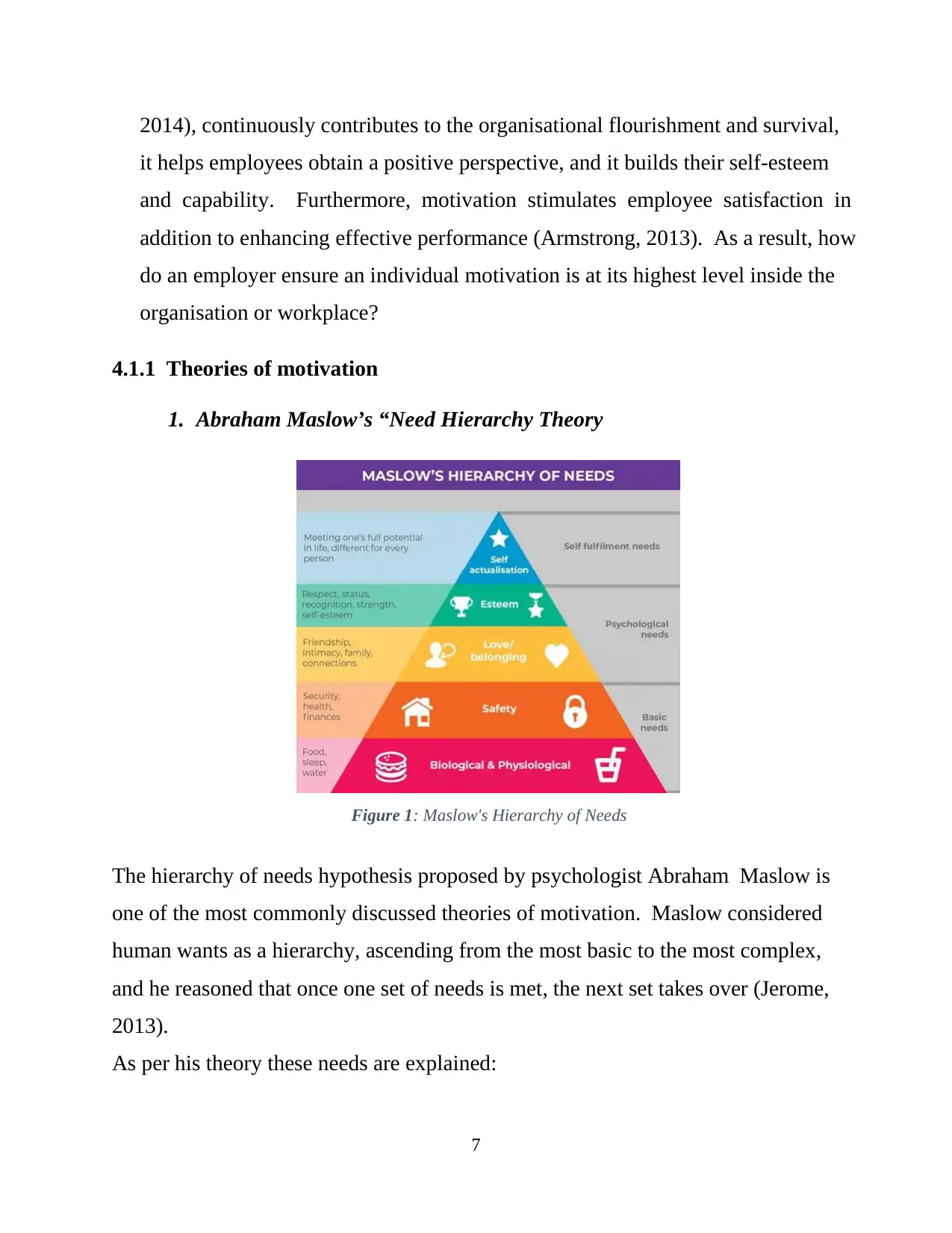
7
2014), continuously contributes to the organisational flourishment and survival,
it helps employees obtain a positive perspective, and it builds their self-esteem
and capability. Furthermore, motivation stimulates employee satisfaction in
addition to enhancing effective performance (Armstrong, 2013). As a result, how
do an employer ensure an individual motivation is at its highest level inside the
organisation or workplace?
4.1.1 Theories of motivation
1. Abraham Maslow’s “Need Hierarchy Theory
The hierarchy of needs hypothesis proposed by psychologist Abraham Maslow is
one of the most commonly discussed theories of motivation. Maslow considered
human wants as a hierarchy, ascending from the most basic to the most complex,
and he reasoned that once one set of needs is met, the next set takes over (Jerome,
2013).
As per his theory these needs are explained:
Figure 1: Maslow's Hierarchy of Needs
2014), continuously contributes to the organisational flourishment and survival,
it helps employees obtain a positive perspective, and it builds their self-esteem
and capability. Furthermore, motivation stimulates employee satisfaction in
addition to enhancing effective performance (Armstrong, 2013). As a result, how
do an employer ensure an individual motivation is at its highest level inside the
organisation or workplace?
4.1.1 Theories of motivation
1. Abraham Maslow’s “Need Hierarchy Theory
The hierarchy of needs hypothesis proposed by psychologist Abraham Maslow is
one of the most commonly discussed theories of motivation. Maslow considered
human wants as a hierarchy, ascending from the most basic to the most complex,
and he reasoned that once one set of needs is met, the next set takes over (Jerome,
2013).
As per his theory these needs are explained:
Figure 1: Maslow's Hierarchy of Needs
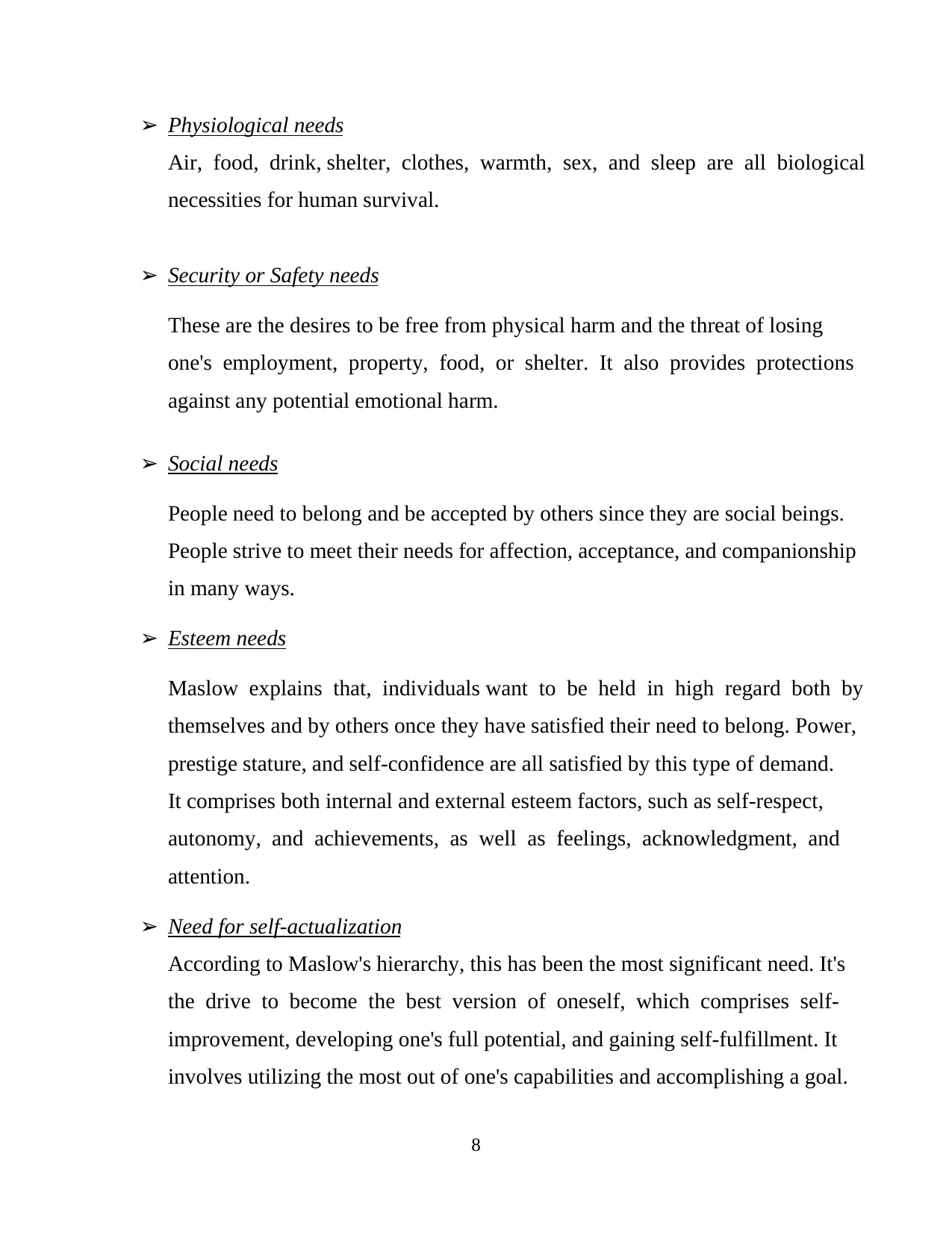
8
➢ Physiological needs
Air, food, drink, shelter, clothes, warmth, sex, and sleep are all biological
necessities for human survival.
➢ Security or Safety needs
These are the desires to be free from physical harm and the threat of losing
one's employment, property, food, or shelter. It also provides protections
against any potential emotional harm.
➢ Social needs
People need to belong and be accepted by others since they are social beings.
People strive to meet their needs for affection, acceptance, and companionship
in many ways.
➢ Esteem needs
Maslow explains that, individuals want to be held in high regard both by
themselves and by others once they have satisfied their need to belong. Power,
prestige stature, and self-confidence are all satisfied by this type of demand.
It comprises both internal and external esteem factors, such as self-respect,
autonomy, and achievements, as well as feelings, acknowledgment, and
attention.
➢ Need for self-actualization
According to Maslow's hierarchy, this has been the most significant need. It's
the drive to become the best version of oneself, which comprises self-
improvement, developing one's full potential, and gaining self-fulfillment. It
involves utilizing the most out of one's capabilities and accomplishing a goal.
➢ Physiological needs
Air, food, drink, shelter, clothes, warmth, sex, and sleep are all biological
necessities for human survival.
➢ Security or Safety needs
These are the desires to be free from physical harm and the threat of losing
one's employment, property, food, or shelter. It also provides protections
against any potential emotional harm.
➢ Social needs
People need to belong and be accepted by others since they are social beings.
People strive to meet their needs for affection, acceptance, and companionship
in many ways.
➢ Esteem needs
Maslow explains that, individuals want to be held in high regard both by
themselves and by others once they have satisfied their need to belong. Power,
prestige stature, and self-confidence are all satisfied by this type of demand.
It comprises both internal and external esteem factors, such as self-respect,
autonomy, and achievements, as well as feelings, acknowledgment, and
attention.
➢ Need for self-actualization
According to Maslow's hierarchy, this has been the most significant need. It's
the drive to become the best version of oneself, which comprises self-
improvement, developing one's full potential, and gaining self-fulfillment. It
involves utilizing the most out of one's capabilities and accomplishing a goal.
⊘ This is a preview!⊘
Do you want full access?
Subscribe today to unlock all pages.

Trusted by 1+ million students worldwide
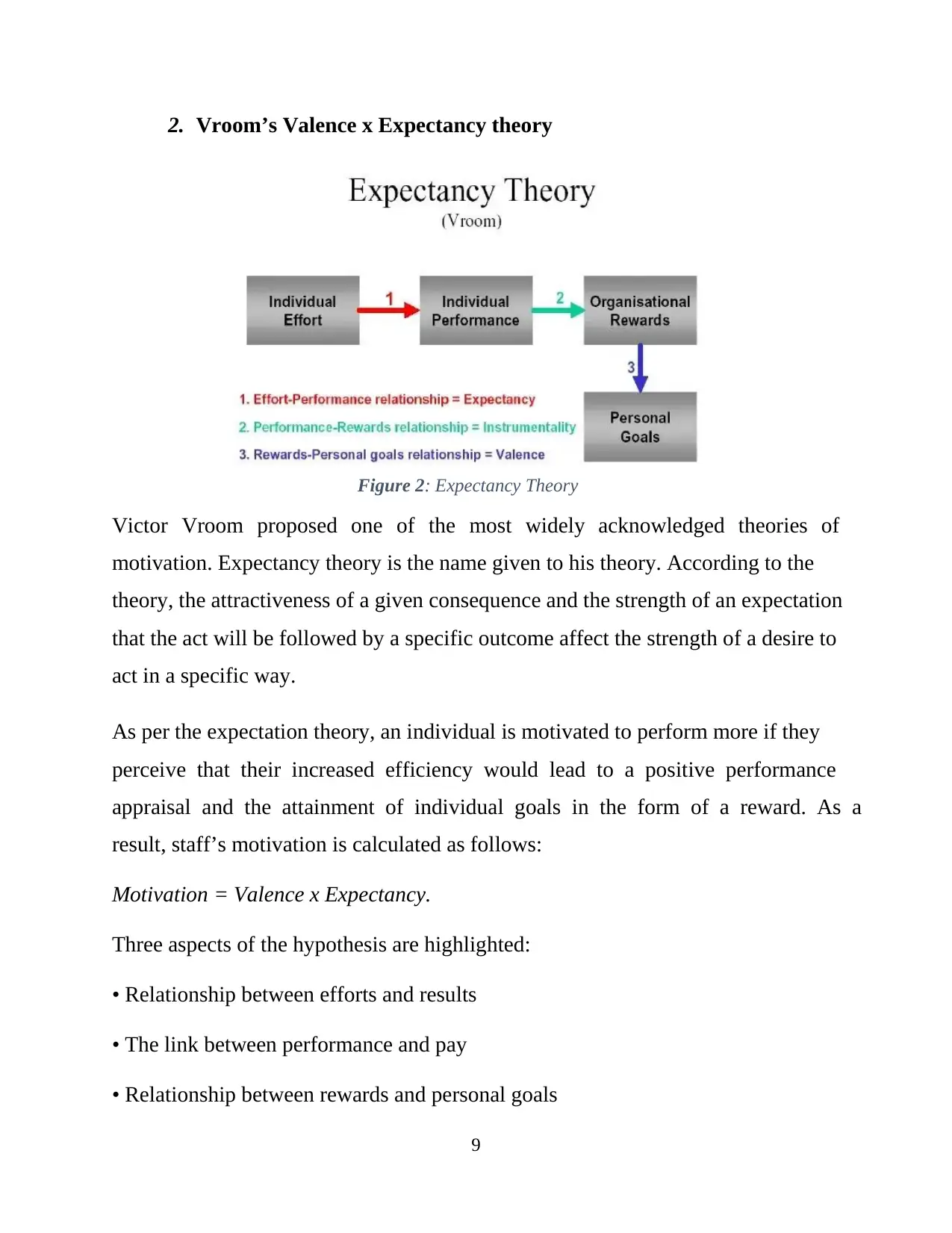
9
2. Vroom’s Valence x Expectancy theory
Victor Vroom proposed one of the most widely acknowledged theories of
motivation. Expectancy theory is the name given to his theory. According to the
theory, the attractiveness of a given consequence and the strength of an expectation
that the act will be followed by a specific outcome affect the strength of a desire to
act in a specific way.
As per the expectation theory, an individual is motivated to perform more if they
perceive that their increased efficiency would lead to a positive performance
appraisal and the attainment of individual goals in the form of a reward. As a
result, staff’s motivation is calculated as follows:
Motivation = Valence x Expectancy.
Three aspects of the hypothesis are highlighted:
• Relationship between efforts and results
• The link between performance and pay
• Relationship between rewards and personal goals
Figure 2: Expectancy Theory
2. Vroom’s Valence x Expectancy theory
Victor Vroom proposed one of the most widely acknowledged theories of
motivation. Expectancy theory is the name given to his theory. According to the
theory, the attractiveness of a given consequence and the strength of an expectation
that the act will be followed by a specific outcome affect the strength of a desire to
act in a specific way.
As per the expectation theory, an individual is motivated to perform more if they
perceive that their increased efficiency would lead to a positive performance
appraisal and the attainment of individual goals in the form of a reward. As a
result, staff’s motivation is calculated as follows:
Motivation = Valence x Expectancy.
Three aspects of the hypothesis are highlighted:
• Relationship between efforts and results
• The link between performance and pay
• Relationship between rewards and personal goals
Figure 2: Expectancy Theory
Paraphrase This Document
Need a fresh take? Get an instant paraphrase of this document with our AI Paraphraser
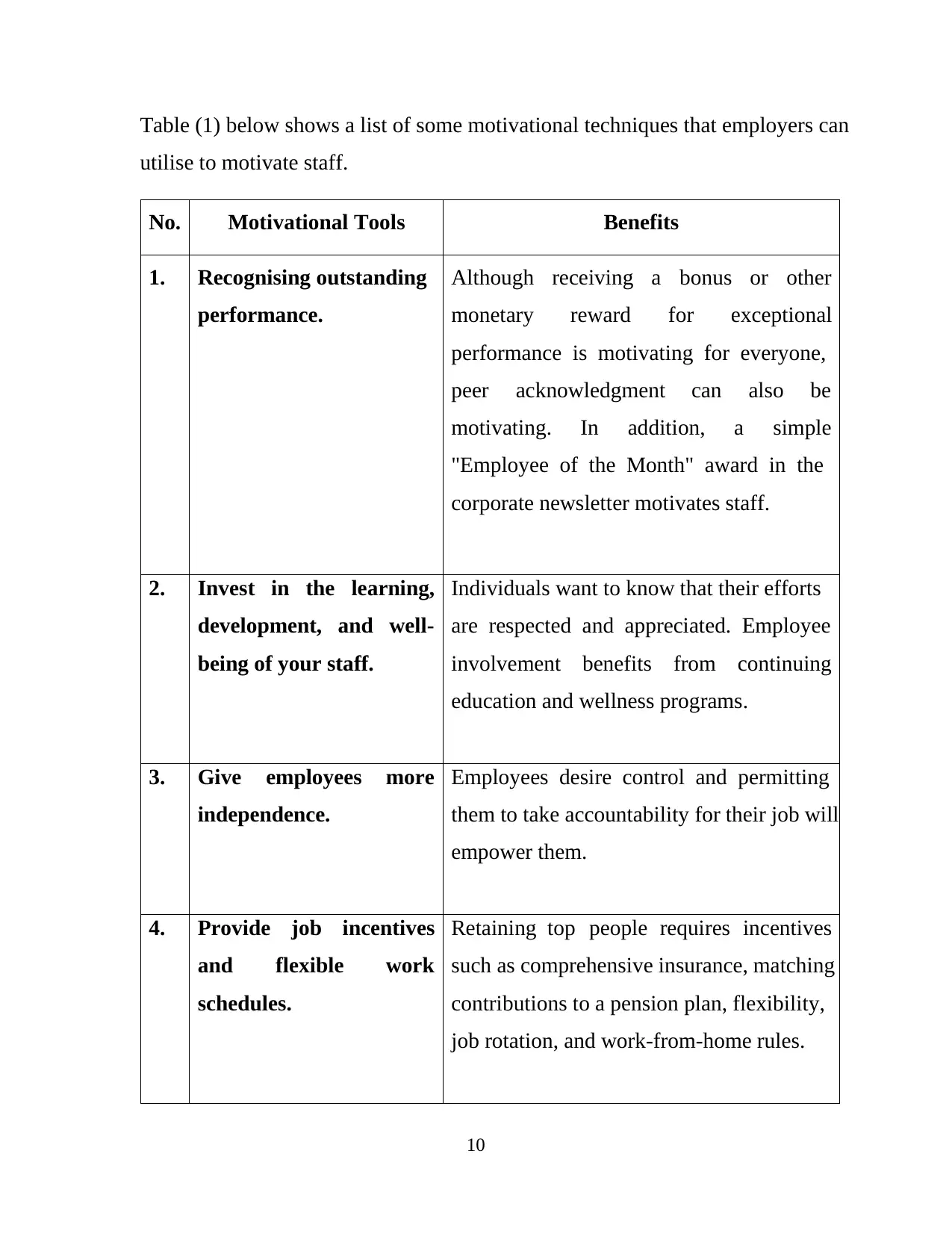
10
Table (1) below shows a list of some motivational techniques that employers can
utilise to motivate staff.
No. Motivational Tools Benefits
1. Recognising outstanding
performance.
Although receiving a bonus or other
monetary reward for exceptional
performance is motivating for everyone,
peer acknowledgment can also be
motivating. In addition, a simple
"Employee of the Month" award in the
corporate newsletter motivates staff.
2. Invest in the learning,
development, and well-
being of your staff.
Individuals want to know that their efforts
are respected and appreciated. Employee
involvement benefits from continuing
education and wellness programs.
3. Give employees more
independence.
Employees desire control and permitting
them to take accountability for their job will
empower them.
4. Provide job incentives
and flexible work
schedules.
Retaining top people requires incentives
such as comprehensive insurance, matching
contributions to a pension plan, flexibility,
job rotation, and work-from-home rules.
Table (1) below shows a list of some motivational techniques that employers can
utilise to motivate staff.
No. Motivational Tools Benefits
1. Recognising outstanding
performance.
Although receiving a bonus or other
monetary reward for exceptional
performance is motivating for everyone,
peer acknowledgment can also be
motivating. In addition, a simple
"Employee of the Month" award in the
corporate newsletter motivates staff.
2. Invest in the learning,
development, and well-
being of your staff.
Individuals want to know that their efforts
are respected and appreciated. Employee
involvement benefits from continuing
education and wellness programs.
3. Give employees more
independence.
Employees desire control and permitting
them to take accountability for their job will
empower them.
4. Provide job incentives
and flexible work
schedules.
Retaining top people requires incentives
such as comprehensive insurance, matching
contributions to a pension plan, flexibility,
job rotation, and work-from-home rules.

11
5. Propose new
responsibilities.
Learning new tasks on the job is mentally
exciting. Employees perceive the
opportunity to take on more responsibilities
as a path to success and increased pay.
Table 1: Motivational tools and its benefits.
5. Propose new
responsibilities.
Learning new tasks on the job is mentally
exciting. Employees perceive the
opportunity to take on more responsibilities
as a path to success and increased pay.
Table 1: Motivational tools and its benefits.
⊘ This is a preview!⊘
Do you want full access?
Subscribe today to unlock all pages.

Trusted by 1+ million students worldwide
1 out of 17
Related Documents
Your All-in-One AI-Powered Toolkit for Academic Success.
+13062052269
info@desklib.com
Available 24*7 on WhatsApp / Email
![[object Object]](/_next/static/media/star-bottom.7253800d.svg)
Unlock your academic potential
Copyright © 2020–2025 A2Z Services. All Rights Reserved. Developed and managed by ZUCOL.




